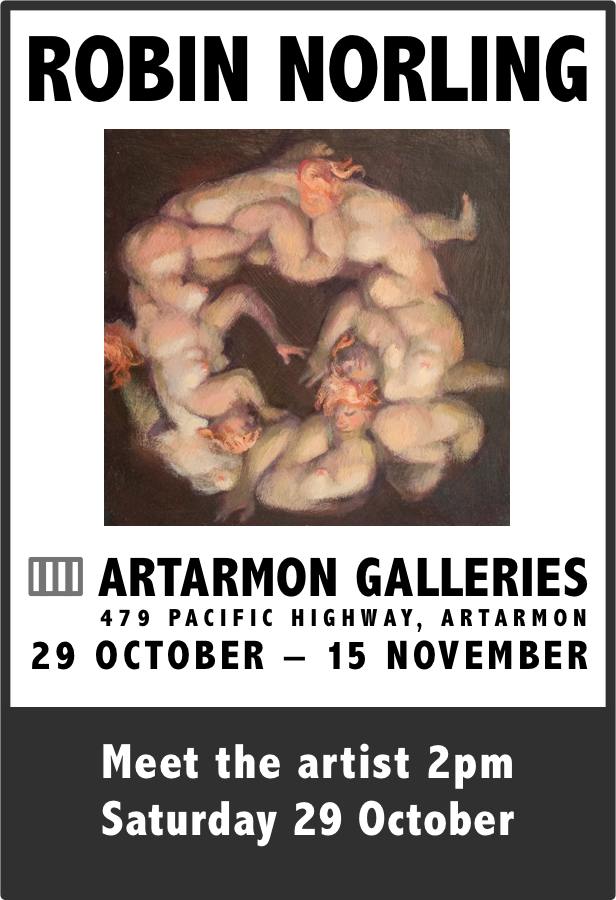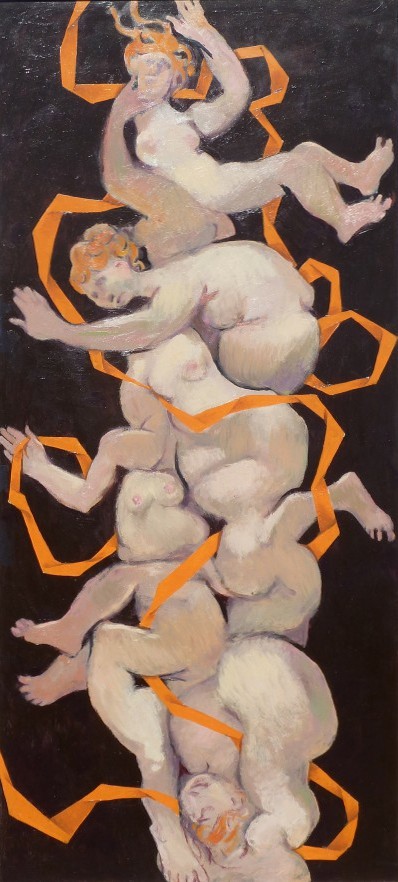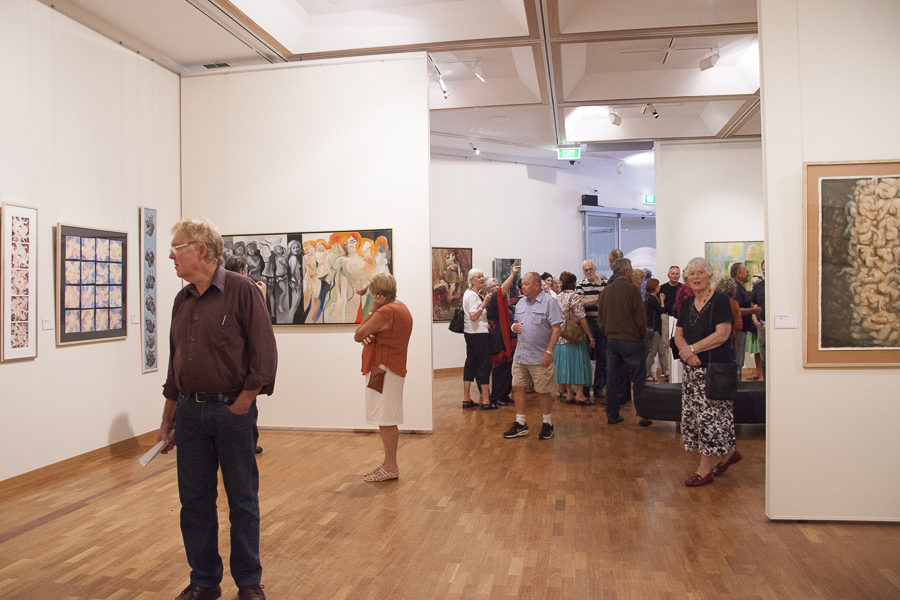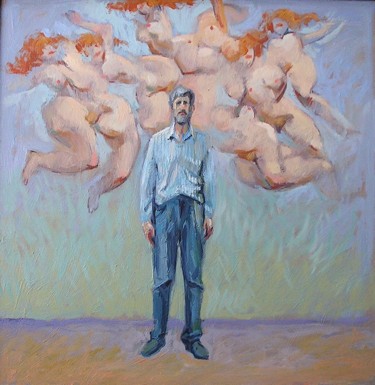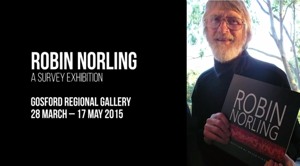Seven photographs from the exhibition Robin Norling: from the artist’s studio, Artarmon Galleries, 29 October – 15 November 2016
Tag Archives: exhibition
Exhibition – Artarmon Galleries
Retrospective exhibition 2016
Robin Norling – metamorphosis
Manning Regional Art Gallery
12 Macquarie Street, Taree
21 April – 5 June 2016
This exhibition reveals a lifetime of art experiments and changes in Robin Norling’s art career. Carefully painting the nude was common practice up to the 1960s and the human body is still a constant theme and challenging to him.
Robin is inspired by both figure and landscape, not to replicate, but to enjoy, re-organising the visual world in his art to achieve unity. He enjoys relating shapes, colours, subtle alignments and hidden geometry, so that the artwork ‘hangs together’ but hopefully does not bore the spectator, a process called composition.
Cinema ad for 2015 exhibition
Advertisement for the exhibition Robin Norling, Gosford Regional Gallery, 28 March – 17 May 2015, played at Avoca Beach Picture Theatre
Pictures from an exhibition
View 30 photographs from the exhibition opening of Robin Norling, Gosford Regional Gallery, 29 March 2015. Images by Danielle Minett, Natural Lights Photography
The art of Robin Norling: delight… and shadow
Catalogue essay for the exhibition Robin Norling, Gosford Regional Gallery, 28 March – 17 May 2015
Most local art prizes have separate sections for “traditional” and “modern” art, and it is usually easy enough to decide which art work goes into which section. But what about the paintings you see before you here? There are some (particularly the earliest nudes) that would not look out of place in a “traditional” section, and others (such as the hexagons) that definitely seem “modern”. However, most of Robin Norling’s paintings defy such easy pigeonholing. While grounded in the visible world – principally art’s oldest subject matter, the human body – they cannot be described simply as “representational”. Instead, they are the results of a series of explorations and experimentations, over fifty years, in the field of painting.
 As with scientific experimentation, in order to make the results meaningful, Norling restricts his “variables” to a relatively narrow range of subjects and ideas. In subject matter, apart from a minor thread of landscape, Norling’s art is almost exclusively about the body: nudes in particular, but also genre scenes and portraits. (Although his work sometimes approaches abstraction, it never completely loses its connection with the visible world.) Using these subjects, he returns again and again to explore a set of ideas, each concerned with how parts of an image come together and interrelate – that is, “composition”. These four ideas are: clustering, grids, metamorphosis, and falling or floating.
As with scientific experimentation, in order to make the results meaningful, Norling restricts his “variables” to a relatively narrow range of subjects and ideas. In subject matter, apart from a minor thread of landscape, Norling’s art is almost exclusively about the body: nudes in particular, but also genre scenes and portraits. (Although his work sometimes approaches abstraction, it never completely loses its connection with the visible world.) Using these subjects, he returns again and again to explore a set of ideas, each concerned with how parts of an image come together and interrelate – that is, “composition”. These four ideas are: clustering, grids, metamorphosis, and falling or floating.
 But what are these experiments? What is it that Norling seeks to prove, or disprove? It is that it is possible to create successful paintings that are simultaneously about the concrete and the universal, and to represent the reality of the visual world while also subtly twisting and pulling that reality for the sake of the underlying idea.
But what are these experiments? What is it that Norling seeks to prove, or disprove? It is that it is possible to create successful paintings that are simultaneously about the concrete and the universal, and to represent the reality of the visual world while also subtly twisting and pulling that reality for the sake of the underlying idea.
To be regarded by Norling as “successful”, a painting must satisfy certain criteria. The most fundamental are the two complementary qualities of interest and unity. Or, to express them in the negative: “Don’t bore, but also don’t confuse.”
There are various ways that Norling’s paintings keep us interested. In the 1970s, the artist experimented with alternatives to the standard rectangular format: the “cut-outs” and the interlocking hexagons. He has also used repeated, fragmented form and blurring to indicate motion. And in a number of paintings the paint surface not only describes flesh but has a luminous, flesh-like quality in itself.
To achieve unity in his art, Norling employs a number of favourite compositional strategies. These include subtle alignments of lines and edges, and the echoing of various visual elements – such as colour and shape – across the picture. He is also very sensitive to the hidden geometry of the rectangular format, letting it guide the placement of forms.
 Notwithstanding Clement Greenberg’s assertion that the pursuit of perfect flatness is intrinsic to modernist art, another of Norling’s criteria for a successful painting is that it should convincingly describe three-dimensional form on a two-dimensional surface. This celebration of what Norling refers to, somewhat prosaically, as “lump” pervades all of his art, from the most representational to the most abstract. And the main technique by which he achieves this is light and shadow. Norling invites us to enjoy the sensuality of every form, every swelling, bump, hollow and valley. While visible enough in his painting, in drawing it is the “main game”.
Notwithstanding Clement Greenberg’s assertion that the pursuit of perfect flatness is intrinsic to modernist art, another of Norling’s criteria for a successful painting is that it should convincingly describe three-dimensional form on a two-dimensional surface. This celebration of what Norling refers to, somewhat prosaically, as “lump” pervades all of his art, from the most representational to the most abstract. And the main technique by which he achieves this is light and shadow. Norling invites us to enjoy the sensuality of every form, every swelling, bump, hollow and valley. While visible enough in his painting, in drawing it is the “main game”.
Finally, a few additional observations about the artist’s place in art history:
In the story of modern Australian art, Robin Norling holds a special place: an innovator who honours artistic tradition (or, as the artist himself has described it, ‘walking backward for the better leap forward’). Norling’s direct contact, during his studies at the Royal College of Art London, with many of the pioneers of Pop art—including Peter Blake, RB Kitaj and Allen Jones—is partly reflected in his work of the 1960s and ’70s, particularly his “cut-outs”. However, at the heart of Pop is an enthusiastic acceptance of consumerism and this was never completely embraced by Norling. So, while it is quite possible that he was a conduit for Pop art into Australia, it may have been more as a ‘carrier’.
Norling’s consistent use of the human body as a central theme of his work puts him in the company of artists such as Kevin Connor, Brett Whiteley and Brian Dunlop. However, his paintings combine rigorous observation with finely tuned composition and a playful touch.
Artists, like Norling, who teach – or have taught – are not uncommon. And many do so with some reluctance: after all, teaching takes time and effort that could be spent making more art. What sets Norling apart, however, is that for him, these two activities are inextricably linked: Teaching is an art; and the best art educates. His art certainly does. It leads us, with gentle humour, into appreciating better the aesthetic delights of the visual world.
Jonathan Cooper, March 2015
Retrospective exhibition 2015
Robin Norling
Gosford Regional Gallery
36 Webb St, East Gosford NSW
28 March – 17 May 2015
This survey of respected Australian artist Robin Norling spans over 50 years. After graduating with Honours from the National Art School, Sydney, he was awarded the Sulman Prize in 1962 and was one of the youngest painters to have won the NSW Travelling Art Scholarship. Norling went on to complete post-graduate studies at the Royal College of Art, London. He later pursued a career as an art educator, including art presenter ABC radio/TV and Senior Education Officer AGNSW. He is best known for his figurative paintings, drawings, sculptures, also landscapes and abstracts.
Opening by Jonathan Cooper, art lecturer AGNSW
Sunday, 29 March, 2pm
Q&A with the artist
Saturday 9 May, 10am
An additional exhibition of Robin’s work is at Patonga Bakehouse Gallery, Patonga (02) 4379 1102







